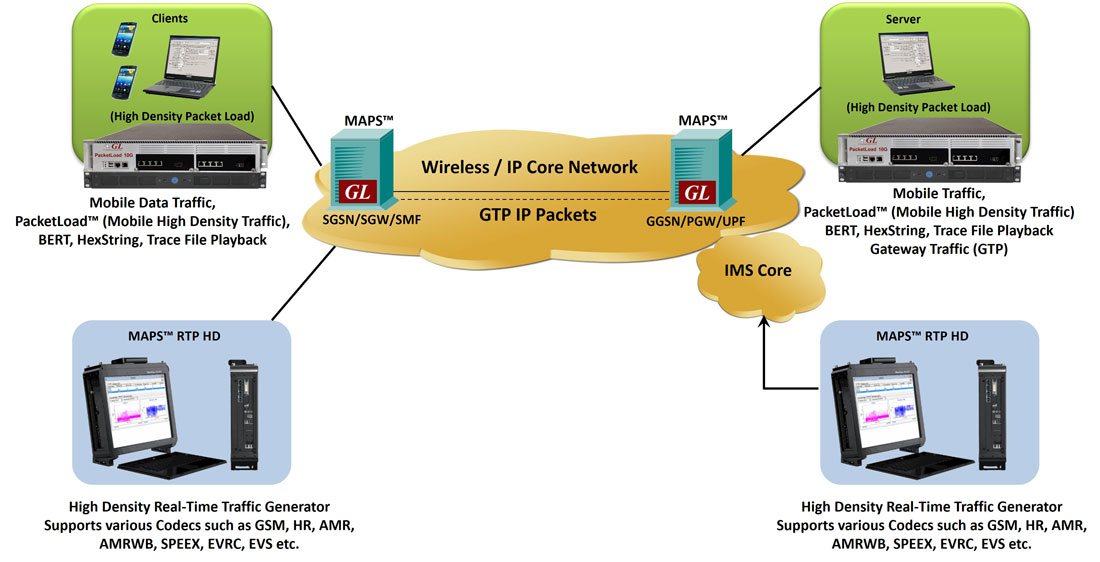High Volume User Traffic Generation over Wireless and IP Core Networks
Welcome to the latest issue of GL's Newsletter providing information and insight into our High Density packet data (HTTP, PCAP) and RTP media emulator referred to as PacketLoad™ and MAPS™ RTP HD appliances, respectively. This solution can emulate up to 100,000 subscribers, 40 Gbps of mobile data traffic and a high volume of voice calls to stress test 5G, 4G, and 3G networks.
Message Automation and Protocol Simulation (MAPS™) platform is the basis for all signaling protocols and traffic generation - which includes voice, tones, digits, fax, data, and video. It covers legacy PSTN, next generation VoIP, wireless equipment, interfaces, and networks. Interfaces can be Analog, TDM, IP/Ethernet or Wireless.

Overview
Testing IP network performance with high sustained call volume and high call intensity is increasingly important to Wireless Carriers, Internet Service Providers, and Equipment vendors to ensure that quality of experience does not degrade with call intensity, volume, or protocol. Load and stress testing are important to verify stability of the IP network and network elements during pre and post deployment.
With GL's advanced bulk call generator appliances PacketLoad™ and MAPS™ RTP HD , users can emulate a high volume of packet data (HTTP, PCAP) sessions or voice calls (RTP).
MAPS™ RTP HD
GL's MAPS™ RTP HD network appliance and advanced bulk call generator is used to emulate a high volume of calls with RTP traffic. It is available as a rackmount network appliance with 4x1GigE or 8x1GigE network interface cards capable of high call intensity (hundreds of calls/secs) and high volume of sustained calls (tens of thousands of simultaneous calls/platform). It can achieve up to 64,000 simultaneous calls per appliance (8,000 calls per port). Using a stack of multiple servers, a larger test system with 100K-200K calls is achievable for enterprise carrier grade testing.
It performs signaling and traffic generation for a vast array of communication protocols covering IP and Wireless networks. Provides non-reference based voice quality using E-model (R-factor) and Mean Opinion Score (MOS) with five mapping scales.
Main Features (MAPS™ RTP HD)
- Create and manage RTP sessions and generate and receive RTP traffic over the sessions with complete automation capability
- Emulate RTP traffic such as voice files, single or dual tones, FAX, and Impairments
- Supports the following Voice Codecs:
- G711 µ-law and A-law with Voice Activity Detection (VAD)
- GSM-FR, HR, EFR
- G729A, G729B, G722, G722.1
- G726 (40K, 32K, 24K, 16K) with VAD
- AMR (codec rates-4.75, 5.15, 5.9, 6.7, 7.4, 7.95, 10.2, 12.2) with VAD (requires additional licenses)
- AMR-WB (Codec rates-6.60 kbps, 8.85 kbps, 12.65 kbps, 14.25 kbps, 15.85 kbps, 18.25 kbps, 19.85 kbps, 23.05 kbps, 23.85 kbps) with VAD (requires additional licenses)
- EVRC, EVRCB, EVRC-C (requires additional licenses)
- SMV, SPEEX, SPEEX-WB, ILBC
- Supports RTP Voice Quality Measurements such as MOS, R-Factor scores
PacketLoad™
As traffic intensity increases, network elements (including switches and transmission) can impart various impairments such as errors, excessive delay, congestion, blocking, loss, and degraded quality. Emulating traffic can be valuable to characterize the impairment as a function of traffic intensity and traffic types.
For such a test requirement, GL's PacketLoad™ appliance can generate up to 100,000 user endpoints along with a high volume of mobile GPRS Tunnelling Protocol (GTP-C) (control plane), GTP-U (user plane) and packet traffic for up to 4 Gbps or 40 Gbps to load test or stress test core 5G, 4G, and 3G networks.
PacketLoad™ can allow different combinations of TCP/HTTP and UDP traffic combined with PCAP Replay to be emulated from both ends of the network. This helps to evaluate end-to-end core network performance with variable signaling and traffic parameters.
Operational Capability
The PacketLoad™ solution offers high density stateful TCP/HTTP, and PCAP Replay traffic types. It encapsulates the generated packet data within GTP headers and transmits through gateways such as Serving GPRS Support Node (SGSN) and Gateway GPRS Support Node (GGSN), Evolved Node B (eNodeB) and Mobility Management Entity (MME) or Serving Gateway (SGW) and Packet Data Network Gateway (PGW) or Next Generation Node B (gNodeB) and User Plane Function (UPF).
The appliance works with MAPS™ 5G N1 N2, MAPS™ 5G N4, MAPS™ LTE S1, MAPS™ LTE eGTP, MAPS™ UMTS Gn Gp, MAPS™ IuPS applications. The 1U MAPS™ Server system controls the PacketLoad™ appliance through Command Line Interface (CLI). At the generating end, MAPS™ automates the process of emulating UEs with different mobile traffic parameters. At the receiving end, MAPS™ with PacketLoad™ verifies the received data and provides various statistics including the total packets transmitted and received, latency, delay, bandwidth, total TCP connections created, successful connections, packet loss, and more.
Supported Applications in 5G, 4G, and 3G Networks
Single Interface Testing in 5G
Emulated gNodeB +AMF (MAPS™ 5G N1N2), UPF (MAPS™ 5G N4) along with the PacketLoad™ appliance can function together to test customer's AMF/UPF, gNB/SMF operations at full load under various traffic conditions and thus perform comprehensive load testing.

Single Interface Testing in 4G
Emulated eNode +MME (MAPS™ LTE S1), PGW (MAPS™ LTE eGTP) along with the PacketLoad™ appliance can function together to test customer's SGW operation at full load under various traffic conditions and thus perform comprehensive load testing.

Single Interface Testing in 3G
MAPS™ Server as Radio Network Controller (RNC) (MAPS™ UMTS IuPS), and GGSN (MAPS™ UMTS Gn Gp) along with PacketLoad™ appliance can function together to test customer's SGSN operation at full load under various traffic conditions and thus perform comprehensive load testing.

 Back to Newsletter Index Page
Back to Newsletter Index Page